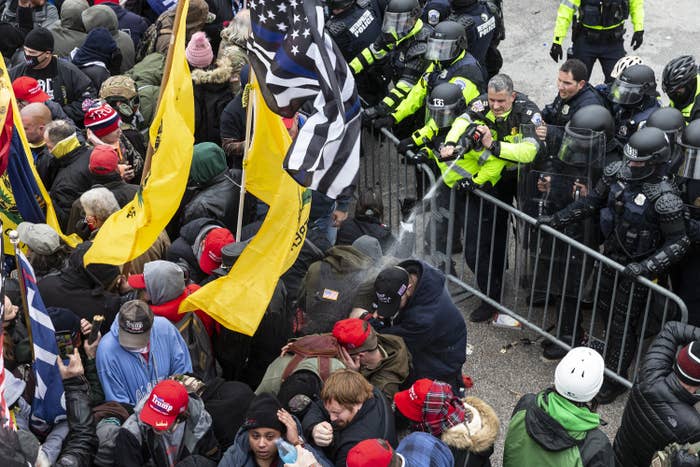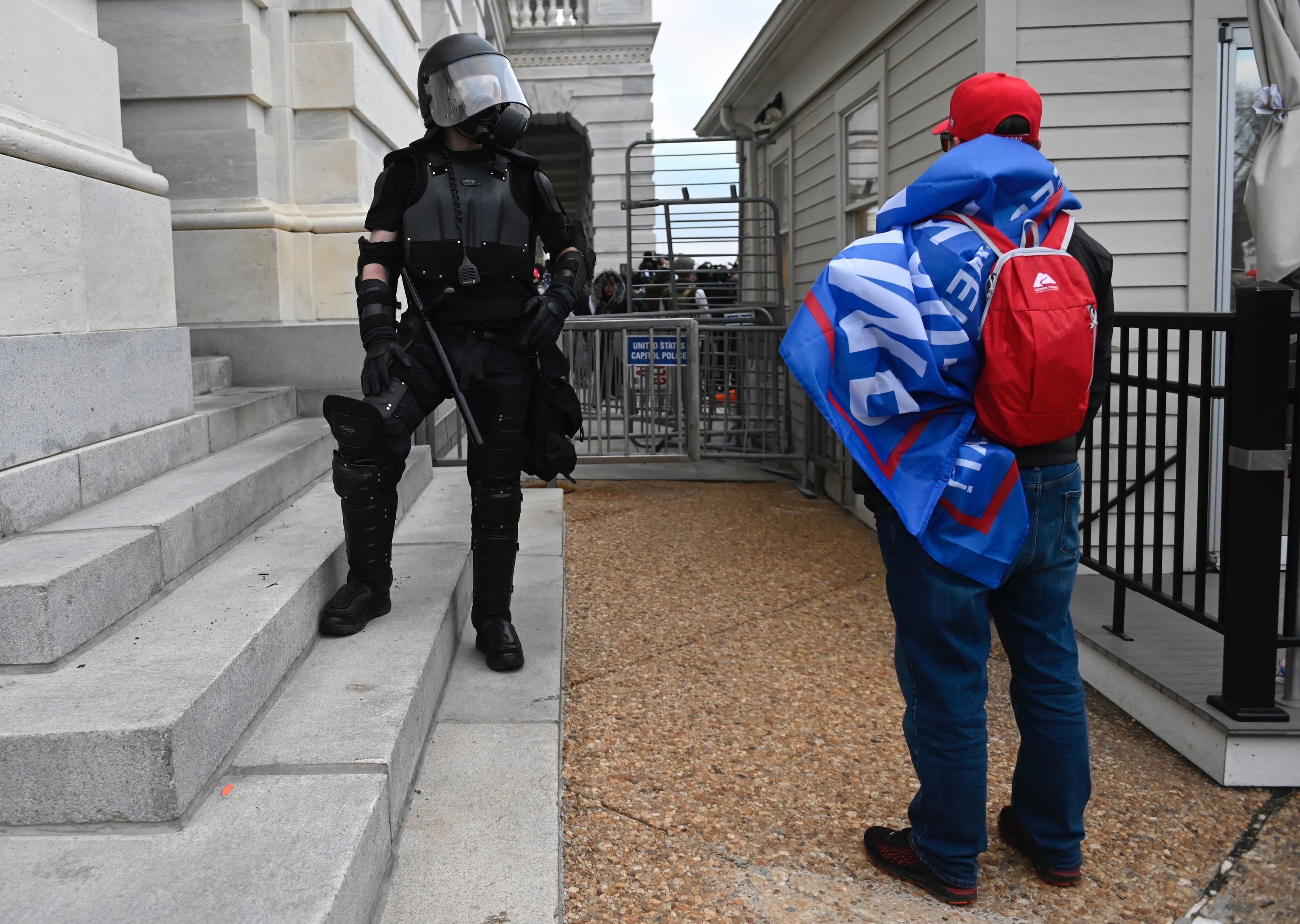
When a violent mob stormed the US Capitol last week, some swinging hockey sticks, others bludgeoning police officers, killing one, the Capitol Police’s lack of preparedness wasn’t the result of a failure — it was how policing has long been designed to work. This is the argument of University of Colorado law professor Aya Gruber, who recently published a paper introducing the concept of “bluelining.”
Gruber argues the police didn’t see the predominantly white mob as “the threat that they were. Even though they’re armed people who are saying, ‘we will do insurrection,’ it was like they couldn’t imagine that that was really going to happen.”
Gruber describes “bluelining” as the way police keep people of color in their designated spaces, usually under the threat of violence. Just as banks infamously engaged in “redlining” — a process by which they denied loans and investments in Black neighborhoods — police operate in those same neighborhoods more aggressively than they do in traditionally white spaces. In this instance, it meant that the Capitol — a public space long controlled by white people — was ceded to the white mob.
Even though rioters posted their plans to storm Washington, DC, weeks in advance and President Donald Trump’s lawyer publicly urged the crowds to engage in “trial by combat,” the agency charged with protecting the Capitol, the Capitol Police, didn’t have sufficient presence or planning. A Black Capitol police officer told BuzzFeed News that he was unable to reach his police chief during the riot.
“Our chief was nowhere to be found, I didn’t hear him on the radio. One of our other deputy chiefs was not there,” he said. “You don’t think it’s all hands on deck?”
The Capitol police chief, Steven Sund, has since resigned. In an interview with the Washington Post, Sund said he requested additional support from other law enforcement agencies but was turned down by his congressional bosses.
Gruber’s bluelining contextualizes the underwhelming response by those charged with securing the Capitol. A long history of white power in Congress, and a sense that its buildings and environs are for white people, made the Hill a traditionally white space. White rioters, according to the concept, weren’t crossing their boundaries — and thus, police leadership underestimated the danger.
Gruber noted that police, particularly its leaders, shared key characteristics with many of the rioters — from their support of Trump to their military backgrounds — which made it harder to separate those shared values with actual danger.
Analysis of US Census data by Gregory Lewis and Rahul Pathak of Georgia State University found that though 6% of the population has served in the armed forces, 19% of police officers are veterans. According to The Marshall Project, law enforcement is the third-most common career for people who served in the military, after truck driving and management.

Some of the imagery of flags and guns and patriots worn by the rioters mirrored images in training tools used by some police departments, like one in Kentucky. Chants of “all cops are friends” could be heard in videos posted online, even as some of the mob attacked those very same officers.
In some instances, the rioters were themselves police officers. A police department in suburban Baltimore suspended an officer who participated in the mob. The Seattle Police Department announced an investigation of two officers who reportedly attended the riots. At least two Capitol police officers have been suspended while being investigated for inappropriate behavior during the riots, including taking selfies with rioters and directing them as they entered the building.
In contrast, security officials deployed multi-agency patrols last summer to handle mostly peaceful Black Lives Matter protesters in front of the White House and other public monuments around the city. Bluelining posits that because many of those protesting racial injustices were Black people in white spaces, law enforcement arrived in riot gear and used tear gas. As civil rights scholars from Gruber to legendary civil rights lawyer Bryan Stevenson have written, to be Black is to have “the presumption of dangerousness.”
Gruber’s bluelining concept traces the disparate treatment of white people storming the Capitol and Black Lives Matter activists encountering a wall of armed forces to the inception of policing itself.
In the South, many police departments started as slave patrols and, following emancipation, as enforcers of the Black Codes, in which freed Black people were arrested and sentenced to work for free in the agricultural fields.
“At harvest time cotton farms experienced an acute need for a large workforce, and it was precisely at such times that the police became most active in discovering vagrants,” historian William Cohen wrote.
In the North, Gruber cites historical records showing that police departments served mainly to suppress labor movements by mostly low-income immigrant workers at the behest of wealthy manufacturing barons. In Buffalo, for example, the number of officers swelled after the Civil War not in a response to any uptick in crime but at the behest of wealthy business owners looking to quash workers organizing for better pay and working conditions. Police were key to strikebreaking across the North, from the Homestead Strike in 1892 in Pennsylvania that challenged the iconic Carnegie Steel Corporation to the Bread and Roses Strike in 1912 in Lawrence, Massachusetts.
“Police departments had nothing to do with crime, and everything to do with maintaining the hierarchical order that was based on race, class, and capitalism,” Gruber says.

The Capitol Police’s flatfooted response tracks with Gruber’s notion of police as enforcers of social hierarchies — particularly as the mobs gathered waving Confederate flags in the aftermath of massive Black and brown voter turnout that flipped a historically white, Republican state like Georgia to blue in both presidential and Senate races.
Gruber notes a woman at the riots whom the Nation quoted as saying, “They’re supposed to shoot BLM, but they’re shooting the patriots.”
“This is the message that has been consistently conveyed over the last 100 years,” Gruber said, “that they [white people] could pretty much do whatever they wanted.”
Gruber discounts the notion that the mob action on the Capitol and the corresponding police inaction was the result of a sophisticated conspiracy between rioters and police, as much as it was institutional legacy.
The legacy of racism embedded in the police force meant that its leaders couldn’t see the threat of an angry white mob. That left Capitol Police Officer Brian Sicknick with little support as he confronted rioters. Without enough assistance, rioters reportedly hit him in the head with a fire extinguisher — a blow that would kill him. Dozens of other officers were beaten with metal bars, flag poles, and even their own shields that had been taken by the mobs.
And all while Blue Lives Matter flags waved in the crowd. ●
